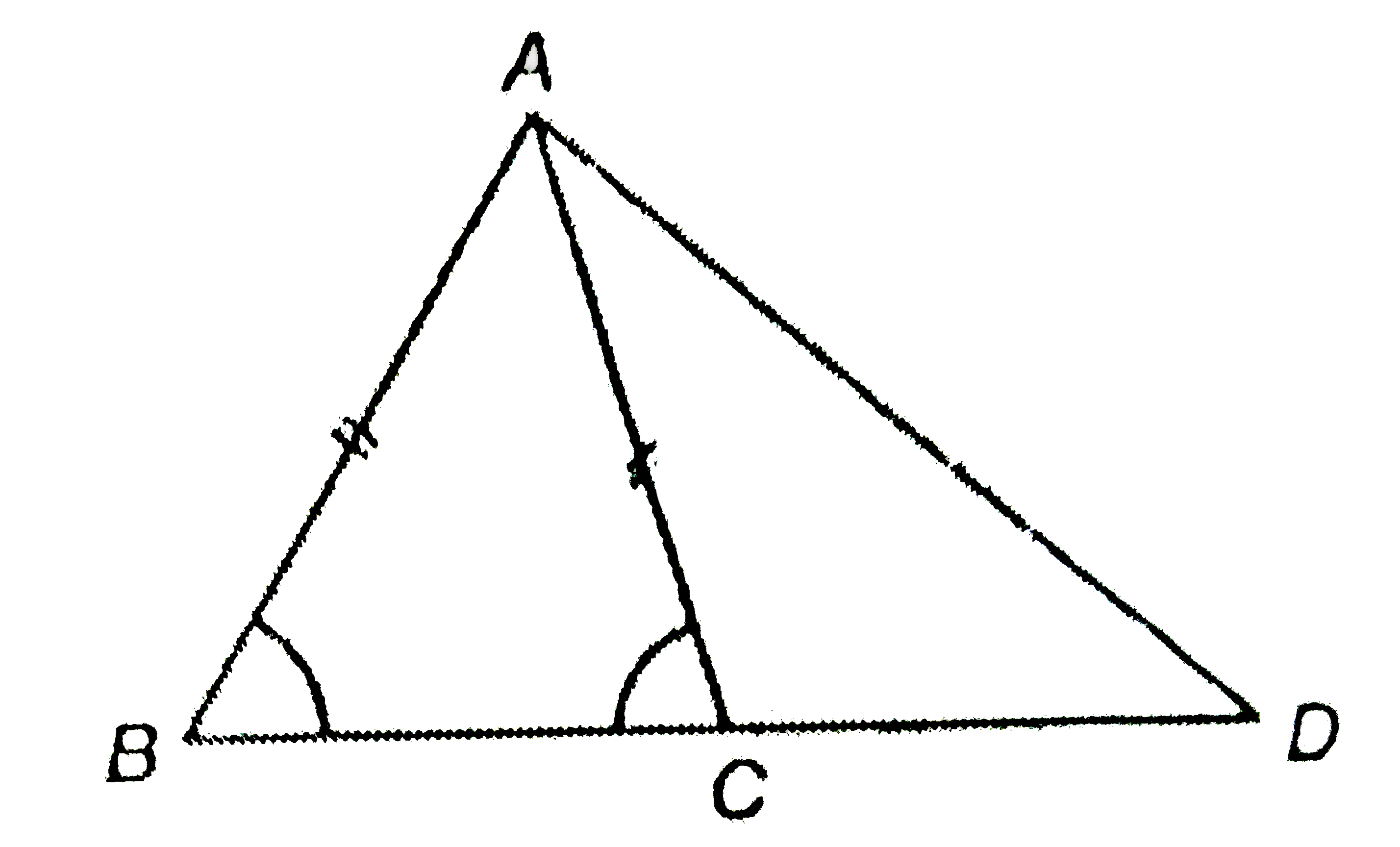In a triangle ABC, D is mid-point of BC, AD is produced upto E so that DE = AD. Prove that :
(i) ΔABDandΔECD are congruent.
(ii) AB = EC
(iii) AB is parallel to EC.
To solve the problem step by step, we will prove the three statements regarding triangles ABD and ECD.
Step 1: Draw Triangle ABC and Identify Points
- Draw triangle ABC.
- Mark D as the midpoint of side BC.
- Extend line AD to point E such that DE = AD.
Hint: Remember that the midpoint divides a line segment into two equal parts.
Step 2: Identify Given Information
- We know that:
- D is the midpoint of BC, so BD = DC.
- AD = DE (as given in the problem).
Hint: Write down all the given information clearly to avoid confusion later.
Step 3: Identify Vertical Angles
- Observe that angles ∠ABD and ∠ECD are vertical angles.
- Therefore, ∠ABD = ∠ECD.
Hint: Vertical angles are always equal; this is a key property in geometry.
Step 4: Apply the SAS Congruence Criterion
- In triangles ABD and ECD, we have:
- AD = DE (given)
- BD = DC (since D is the midpoint)
- ∠ABD = ∠ECD (vertical angles)
- By the SAS (Side-Angle-Side) congruence criterion, we can conclude that:
- Triangle ABD ≅ Triangle ECD.
Hint: Recall the SAS criterion: if two sides and the included angle of one triangle are equal to two sides and the included angle of another triangle, the triangles are congruent.
Step 5: Prove AB = EC
- Since triangles ABD and ECD are congruent, by CPCT (Corresponding Parts of Congruent Triangles), we have:
- AB = EC.
Hint: CPCT is a direct consequence of triangle congruence; always check corresponding parts after proving congruence.
Step 6: Prove AB is Parallel to EC
- From the congruence of triangles ABD and ECD, we also have:
- ∠BAD = ∠DCE (by CPCT).
- Since ∠BAD and ∠DCE are alternate interior angles formed by the transversal AD intersecting lines AB and EC, we can conclude that:
- AB || EC.
Hint: Remember that if two lines are cut by a transversal and the alternate interior angles are equal, then the lines are parallel.
Final Conclusion
We have successfully proven:
1. Triangle ABD ≅ Triangle ECD.
2. AB = EC.
3. AB is parallel to EC.
- Draw triangle ABC.
- Mark D as the midpoint of side BC.
- Extend line AD to point E such that DE = AD.
- We know that:
- D is the midpoint of BC, so BD = DC.
- AD = DE (as given in the problem).
- Observe that angles ∠ABD and ∠ECD are vertical angles.
- Therefore, ∠ABD = ∠ECD.
- In triangles ABD and ECD, we have:
- AD = DE (given)
- BD = DC (since D is the midpoint)
- ∠ABD = ∠ECD (vertical angles)
- By the SAS (Side-Angle-Side) congruence criterion, we can conclude that:
- Triangle ABD ≅ Triangle ECD.
- Since triangles ABD and ECD are congruent, by CPCT (Corresponding Parts of Congruent Triangles), we have:
- AB = EC.
- From the congruence of triangles ABD and ECD, we also have:
- ∠BAD = ∠DCE (by CPCT).
- Since ∠BAD and ∠DCE are alternate interior angles formed by the transversal AD intersecting lines AB and EC, we can conclude that:
- AB || EC.
We have successfully proven:
1. Triangle ABD ≅ Triangle ECD.
2. AB = EC.
3. AB is parallel to EC.
Topper's Solved these Questions
- TRIANGLES BOOK - ICSECHAPTER - TRIANGLES EXERCISE - EXERCISE 9(B)
20 Videos
- TRIANGLES BOOK - ICSECHAPTER - TRIANGLES EXERCISE - QUESTIONS
8 Videos
- STATISTICS AND GRAPH WORK BOOK - ICSECHAPTER - STATISTICS AND GRAPH WORK EXERCISE - TOPIC - 2 (4 Marks Questions)
14 Videos
- TRIGONOMETRICAL RATIOS BOOK - ICSECHAPTER - TRIGONOMETRICAL RATIOS EXERCISE - EXERCISE 22(B)
50 Videos
Similar Questions
In a ΔABC,D in mid-point of BC, AD is produced upto E so that DE=AD, prove that :
(i) ΔABD and ΔECD are congruent (ii) AB=EC
(iii) AB is parallel to EC.
View SolutionIn a triangle ABC,D is the mid - point of BC, AD is produced upto E so that DE = AD.
Prove that :
AB=EC
View SolutionIn a ΔABC, BD is the median to the side AC, BD is produced to E such that BD = DE. Prove that : AE is parallel to BC.
View SolutionIn isosceles triangle ABC, D is a point on the base BC produced. Prove that AD>AB.

View SolutionIn a triangle ABC,B=90∘ and D is the mid-oint of BC then prove that AC2=AD2+3CD2
View SolutionIn the given figure, DE // BC.

Prove that ΔADEandΔABC are similar
View SolutionAny point D is taken on the side BC of a ΔABC and AD is produced to E such that AD = DE , prove that area of ΔBCE= area of ΔABC,
View SolutionIn an isosceles triangle ABC, AB = AC and D is a point on BC produced. Prove that :
AD2=AC2+BD.CD
View SolutionIn triangle ABC, AB > AC. E is the mid-point of BC and AD is perpendicular to BC. Prove that : AB2+AC2=2AE2+2BE2

View SolutionIn a triangle ABC, AB = BC, AD is perpendicular to side BC and CE is perpendicular to side AB. Prove that : AD = CE.
View Solution
